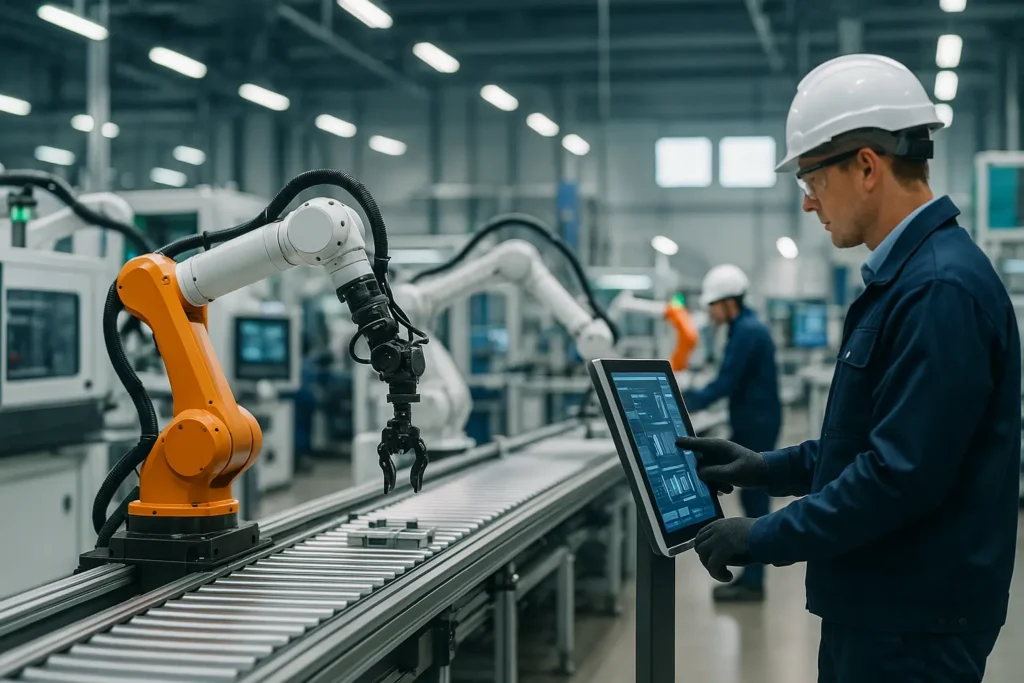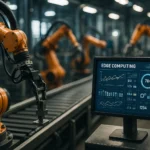In a world where technology is continuously reshaping our everyday lives, the industrial landscape is no exception. It’s 2025, and the term ‘Smart Factory‘ has emerged as a buzzword, synonymous with cutting-edge innovation and efficiency. But what does it truly mean for a factory to be ‘smart’? As we dive into the heart of this revolution, we’ll explore how automation, data, and digital advancements are converging to redefine production processes and operations. Our journey will provide a lens into the technologies that are reshaping factories, making them not just efficient but also adaptive and intelligent.
The DNA of Smart Factories
When we think of a smart factory, several images might spring to mind: sleek robots, seamlessly automated assembly lines, or perhaps, omnipresent data streams. Yet, these elements are only fragments of a more complex puzzle. At the core of a smart factory lies an interconnected ecosystem where systems, processes, and people integrate harmoniously to optimize operations.
One defining feature is the role of data. In these factories, data isn’t just accumulated; it’s the very lifeblood that drives every decision and action. Real-time data analytics empower businesses to identify inefficiencies, anticipate potential breakdowns, and streamline production. This means leveraging technologies like Internet of Things (IoT), which allows machinery to communicate, ensuring that everything runs smoothly.
Moreover, smart factories utilize automation in novel ways. Where traditional factory settings relied heavily on human intervention, today’s smart plants inherently aim to minimize manual tasks. This doesn’t merely equate to replacing people with machines; rather, it’s about augmenting human abilities with technology to enhance productivity.
Additionally, there’s a shift towards more adaptive and flexible manufacturing. Smart factories capitalize on modular systems that cater to fluctuating market demands. This agility is crucial in a world where consumer preferences evolve rapidly.
What, then, makes a factory truly ‘smart’? It’s the fusion of data, technology, and human ingenuity that creates a seamless, digitally enhanced manufacturing environment.
Smart Manufacturing: Bridging the Old with the New
Transitioning from traditional manufacturing to smart manufacturing isn’t just about technology. It’s about bridging the gap between established practices and new-age innovations. While we might conjure images of robots and digital displays, the heart of this evolution lies in the way processes and systems are re-imagined.
One significant factor is the integration of legacy systems with modern technologies. Not every factory starts with a clean slate. Instead, businesses must navigate the challenges of integrating new industrial technologies with existing infrastructure. This involves strategic investments in smart technology that can retrofit older machinery, ensuring that the entire manufacturing chain benefits from digital enhancements.
Another critical factor is sustainability. Next-gen plants are increasingly conscious of their environmental impact. By leveraging data and automation, factories can significantly reduce waste, optimize energy consumption, and make more sustainable choices. These operations not only meet industry standards but also resonate with environmentally conscious consumers.
However, the human component remains pivotal. While automation handles repetitive tasks, humans drive creativity and strategic decisions. Thus, upskilling the workforce is paramount. As we adopt smart technologies, there’s a parallel emphasis on training our teams to work alongside intelligent systems, ensuring a symbiotic relationship where both human and machine thrive.
In essence, smart manufacturing isn’t merely a technological overhaul; it’s a strategic fusion of the old and new, ensuring businesses are not only productive but also innovative and responsible.
Harnessing the Power of Data and Automation
Data is the fuel powering the smart factory engine. Yet, it’s not simply about collecting information—it’s about turning it into actionable insights that transform business operations. In today’s industry, where time and efficiency are critical, the ability to analyze and act on data in real-time provides a distinct competitive edge.
Consider the role of predictive maintenance. Through continuous monitoring and data analysis, factories can foresee equipment failures before they occur. This technology reduces downtime, saves costs, and ensures smoother production processes. Moreover, the integration of automation technologies means that many of these insights can be acted upon without human intervention, further streamlining operations.
Furthermore, automation in smart factories goes beyond simple mechanical tasks. Automation systems now manage complex processes, from supply chain logistics to production scheduling. By doing so, they free up human resources for more strategic roles, aligning with the overarching goal of enhancing productivity and innovation.
The interconnectedness of these technologies creates a digital thread running through the entire industrial ecosystem. From suppliers to end-users, every aspect of the manufacturing chain benefits from increased transparency and efficiency. The seamless flow of information ensures that business decisions are well-informed, timely, and impactful.
Harnessing data and automation isn’t about replacing human intuition; it’s about amplifying it with real-time insights and capabilities that make smart factories truly futuristic.
The Human Element in Smart Factories
As we venture deeper into the realms of smart manufacturing, it’s crucial to remember that the human element remains an integral part of this evolution. While technology and automation redefine factory processes, the role of human intuition, creativity, and decision-making cannot be understated.
Smart factories are not just about machines and data; they’re about creating an ecosystem where human potential is maximized. As factories become more digital, there’s an increased emphasis on building a workforce that is tech-savvy and adaptable. Training programs and workshops are becoming essential in equipping employees with the skills needed to thrive alongside advanced systems.
Moreover, the collaborative nature of smart factories fosters innovation. By minimizing repetitive tasks, employees can focus on strategic and creative endeavors. This shift not only enriches their work experience but also drives business growth. In this sense, smart factories are as much about cultural transformation as they are about technological advancement.
It’s also essential to consider the evolving roles within these next-gen plants. Traditional roles are transforming into hybrid positions, merging technical know-how with managerial acumen. This change demands a new breed of leaders who can navigate both the industrial and digital realms effectively.
In conclusion, while technology and automation might be the backbone of smart factories, it’s the human element that brings heart, innovation, and strategic direction to these operations.
In the grand scheme of industry evolution, the term ‘smart factory‘ encapsulates more than just a technological upgrade. It represents a paradigm shift in how we approach manufacturing—merging data, innovation, and human ingenuity to create environments that are not only efficient but also resilient and visionary.
As we reflect on this journey, we recognize that the future of factories lies in their ability to adapt, evolve, and embrace the endless possibilities offered by modern technologies. But even more crucial is the emphasis on maintaining a harmonious balance between technology and humanity. After all, it’s this blend that ensures that while factories become smarter, they remain rooted in their fundamental purpose: creating value, fostering innovation, and propelling business success.
FAQ
What defines a ‘smart’ factory?
A ‘smart’ factory is characterized by its advanced integration of digital technologies, enabling seamless communication between machines, systems, and humans to enhance efficiency, flexibility, and productivity.
How do smart factories utilize the Internet of Things (IoT)?
Smart factories employ IoT to connect various machines and equipment, allowing them to share data in real-time. This connectivity facilitates remote monitoring, predictive maintenance, and data-driven decision-making.
What role does artificial intelligence (AI) play in smart factories?
AI in smart factories is used to analyze large sets of data to optimize production processes, predict equipment failures, and improve quality control. It enables machines to learn from data and make autonomous decisions.
How do smart factories improve operational efficiency?
Smart factories enhance operational efficiency by automating repetitive tasks, reducing downtime through predictive maintenance, and streamlining supply chain processes, ultimately resulting in faster production times and reduced waste.
What challenges do companies face when transitioning to smart factories?
The transition to smart factories may pose challenges such as high initial investment costs, the need for skilled workforce training, cybersecurity risks, and integration complexities with existing systems.



